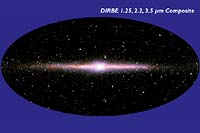|
COMETS EARTH JUPITER KUIPER BELT MARS MERCURY METEORITES NEPTUNE OORT CLOUD PLUTO SATURN SOLAR SYSTEM SPACE SUN URANUS VENUS ORDER PRINTS
PHOTO CATEGORIES SCIENCEVIEWS AMERICAN INDIAN AMPHIBIANS BIRDS BUGS FINE ART FOSSILS THE ISLANDS HISTORICAL PHOTOS MAMMALS OTHER PARKS PLANTS RELIGIOUS REPTILES SCIENCEVIEWS PRINTS
|
Related Document
Download Options
False-color image of the near-infrared sky as seen by the DIRBE. Data at 1.25, 2.2, and 3.5 Ám wavelengths are represented respectively as blue, green and red colors. The image is presented in Galactic coordinates, with the plane of the Milky Way Galaxy horizontal across the middle and the Galactic center at the center. The dominant sources of light at these wavelengths are stars within our Galaxy. The image shows both the thin disk and central bulge populations of stars in our spiral galaxy. Our Sun, much closer to us than any other star, lies in the disk (which is why the disk appears edge-on to us) at a distance of about 28,000 light years from the center. The image is redder in directions where there is more dust between the stars absorbing starlight from distant stars. This absorption is so strong at visible wavelengths that the central part of the Milky Way cannot be seen. DIRBE data will facilitate studies of the content, energetics and large scale structure of the Galaxy, as well as the nature and distribution of dust within the Solar System. The data also will be studied for evidence of a faint, uniform infrared background, the residual radiation from the first stars and galaxies formed following the Big Bang. |
